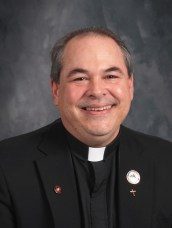The earliest Catholic families of Brown County, Illinois were served as a mission parish by traveling priests based principally in Quincy. Services then were conducted in private homes, the pioneers assembling to worship their God amidst the harsh elements and in humble cabins. The first pastor was assigned to the people of Brown County by Bishop Kendrick of the Alton diocese in 1947. Two years later the Catholic families under his guidance had constructed their first Church, a brick structure costing nearly $400. This house of worship was named St. Patrick’s and stood far back from West North Street, west of the present Brown County Farm Bureau building.
Shortly after this period the number of Catholic families in this area increased tremendously. The vehicle was immigration, and the principle causes were the Irish potato famine of 1846 and the wave of continental European revolutions of 1848. A larger church structure was clearly required. In 1862 came the building of the present St. Mary’s Church and the formation of a parish of that name. The church, then the largest in Brown County, cost an astounding $10,000. Its first mass was celebrated on Christmas day, 1864.
St. Mary’s parish was already operating a one room school prior to 1864, and that structure was expanded in 1873. Other construction included a rectory in 1878 and a convent in 1884. The rectory was rebuilt in its present opulence about 1900, as the earlier structure was badly damaged by fire in November 1899. the pastor, Fr. Ryan, was severely burned attempting to salvage records in that disaster, and died of those injuries a few months later. In 1907 came Fr. Wm. Hefferman who founded St. Mary’s Academy. Ground was broken for this fine educational institution on St. Patrick’s Day 1908. School was in session with dedication by Bishop James Ryan in September of that same year. The first high school class graduated in 1912. Enrollment reached 200 by the 1920’s. In 1953 the Academy was renovated and a new gym was added in 1956. The high school program was discontinued with the graduating class of 1969, but the school continues as an eight year grade school espousing academic excellence and personal discipline.
The Church of St. Mary’s was renovated during the pastorate of the late Msgr. Fox, 1927-1929, and again during the pastorate of Fr. Louis Shea, 1970-1977. Major gifts to the parish include 31/2 ares for playground and ball diamond by Fr. Marley, and Wicks pipe organ from his estate in 1964; also 20 acres of farm land from the estate of Pat Neylon in 1957. The parish of St. Mary’s has given the Roman Catholic Church:Fathers George Gannon, Terrance Brady(whose life was lost in the Solomon Island in World War II), and Robert Borenkircher,O.P.; also Sisters M. Sara Koch, M. Marcille Koch, M. Consolata Franklin, M. Robert Armstorg, M. Marcelline Redmond, M. Mildred Gosche, M. Clarissa Higgins, M. Pius McGuire, M. Clare Neylon, M. Cronin, M. Ceslaus O’Conner, M. Marie Weigan, M. Vincentia Factor, M. Andrea Cullivan, M. Constance Cronin and M. Geraldine McEntee.
In 1868 the German speaking families expressed a desire for a pastor who could preach to them in their own language. They thus received permission to form their own parish, and St. Joseph’s came into being. A frame church was constructed the next year to serve about thirty-five native born Germanic families. The present church structure was erected by that congregation in 1885, and the old frame edifice became the parish school. Prior to this time, school, presumably in the German language was, conducted in the frame residence on East Main Street, home of the late Albert Hickman, and then in a log structure directly across South Street from the present Church.
As a small parish was able, improvements were added including the charming Victorian rectory of brick in 1898. The earlier frame rectory then saw service as a convent for the Sisters of the Precious Blood, and then the school Sisters of Notre Dame. St. Joseph’s parish reached a decision in 1922 to terminate their grade school, becoming an integral part of St. Mary’s Academy thereafter. The convent was converted into the present parish hall.
The church structure of St. Joseph’s was extensively renovated during the pastorate of Fr. O’Donoghue 1942-39, and again under the pastorate of Fr. Burtle, 1939-1956. Fr. Burtle made a lasting contribution to the combined parishes of St. Joseph’s and St. Mary’s by his founding a chapter of the Nocturnal Adoration Society which flourishes strongly today. Other contributions to the parish include the stations of the cross from the Peter Markert family, a speaker system and confessional from the Breidenbend family, a communion rail from Mrs. Albert Koch and the automatic angelus peel from Mrs. Anna Reid, which bells ring throughout Mt. Sterling.
The parish has generously returned thanks by giving from its members at least the following religious: Fathers Schneider, Wm. J. Weigand, who built St. Alexis Church of Beardstown, Anton L. Kunkle, and Cyril Wagner; Also Sisters M. Bonaventure, M. Vincentia, M. Jovita, M. Alodias, M. Samuella, M. Joan and M. Adelia.
The combined parishes of St. Joseph’s and St. Mary’s have for well over 125 years contributed greatly to the moral, social and economic life of Brown County. Their congregations stress a strong family unit as the basic backbone of today’s society, and strong devotion to the church of one’s belief as the key to development of their children as responsible citizens for the future of this community.





